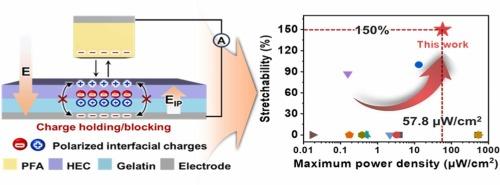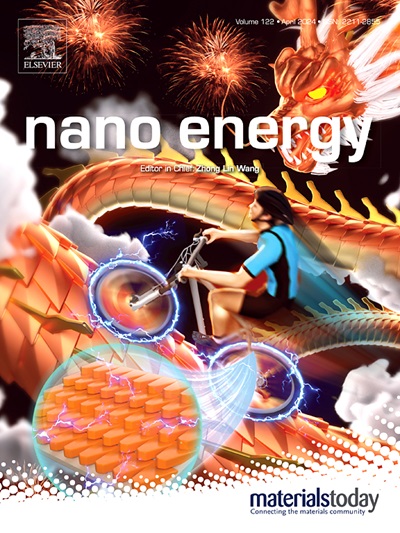Biodegradable, stretchable, and high-performance triboelectric nanogenerators through interfacial polarization in bilayer structure
IF 16.8
1区 材料科学
Q1 CHEMISTRY, PHYSICAL
引用次数: 0
Abstract
The increasing demand for wearable electronics has led to the development of triboelectric nanogenerators (TENGs) as a promising energy harvesting and sensing technology. However, conventional TENGs often utilize non-biodegradable materials, contributing to environmental pollution. In this work, we present a stretchable and biodegradable TENG based on hydroxyethyl cellulose (HEC) and gelatin (HG-TENG). The HG-TENG features a bilayered structure, where the large difference in their relative permittivity between HEC and gelatin induces interfacial polarization, effectively mitigating charge recombination and enhancing triboelectric performance. The optimized HG-TENG achieves an open-circuit voltage (Voc) of 93 V, a maximum power density of 57.8 µW/cm2, and can power 38 blue light-emitting diodes. The device exhibits a stretchability of 150 % and biodegrades within 3 hours in phosphate-buffered saline. Furthermore, we demonstrate the application of the HG-TENG as a wearable sensor by modifying it with trichloro(1H, 1H, 2H, 2H-perfluorooctyl)silane (FOTS) (FHG-TENG). The FHG-TENG-based smart glove, integrated with machine learning algorithms, enables real-time monitoring of blood pressure waveforms and finger motions, showcasing its potential for human-machine interfaces. The smart glove, equipped with five FHG-TENGs on the proximal interphalangeal joints of each finger, detects diverse finger gestures and generates voltage signals that control a robotic hand in real-time, demonstrating effective human-machine interaction through synchronized motion. Moreover, the smart glove achieves a high recognition accuracy of 96.15 % for 10 different hand sign languages.

通过双层结构中的界面极化实现可生物降解、可拉伸和高性能的三电纳米发电机
随着对可穿戴电子设备的需求日益增长,三电纳米发电机(TENGs)作为一种前景广阔的能量采集和传感技术应运而生。然而,传统的 TENG 通常使用不可生物降解的材料,造成环境污染。在这项工作中,我们提出了一种基于羟乙基纤维素(HEC)和明胶的可拉伸、可生物降解的 TENG(HG-TENG)。HG-TENG 具有双层结构,其中羟乙基纤维素和明胶之间的相对介电常数差异较大,可诱导界面极化,有效缓解电荷重组,提高三电性能。优化后的 HG-TENG 的开路电压(Voc)达到 93 V,最大功率密度为 57.8 µW/cm2,可为 38 个蓝色发光二极管供电。该器件的伸展性为 150%,在磷酸盐缓冲盐水中可在 3 小时内生物降解。此外,我们还用三氯(1H,1H,2H,2H-全氟辛基)硅烷(FOTS)(FHG-TENG)对 HG-TENG 进行了改性,展示了它作为可穿戴传感器的应用。基于 FHG-TENG 的智能手套集成了机器学习算法,能够实时监测血压波形和手指运动,展示了其在人机界面方面的潜力。该智能手套在每个手指的近端指间关节上配备了五个 FHG-TENG,可检测到各种手指手势并产生电压信号,从而实时控制机器人手,通过同步运动展示了有效的人机交互。此外,该智能手套对 10 种不同手势语言的识别准确率高达 96.15%。
本文章由计算机程序翻译,如有差异,请以英文原文为准。
求助全文
约1分钟内获得全文
求助全文
来源期刊

Nano Energy
CHEMISTRY, PHYSICAL-NANOSCIENCE & NANOTECHNOLOGY
CiteScore
30.30
自引率
7.40%
发文量
1207
审稿时长
23 days
期刊介绍:
Nano Energy is a multidisciplinary, rapid-publication forum of original peer-reviewed contributions on the science and engineering of nanomaterials and nanodevices used in all forms of energy harvesting, conversion, storage, utilization and policy. Through its mixture of articles, reviews, communications, research news, and information on key developments, Nano Energy provides a comprehensive coverage of this exciting and dynamic field which joins nanoscience and nanotechnology with energy science. The journal is relevant to all those who are interested in nanomaterials solutions to the energy problem.
Nano Energy publishes original experimental and theoretical research on all aspects of energy-related research which utilizes nanomaterials and nanotechnology. Manuscripts of four types are considered: review articles which inform readers of the latest research and advances in energy science; rapid communications which feature exciting research breakthroughs in the field; full-length articles which report comprehensive research developments; and news and opinions which comment on topical issues or express views on the developments in related fields.
 求助内容:
求助内容: 应助结果提醒方式:
应助结果提醒方式:


